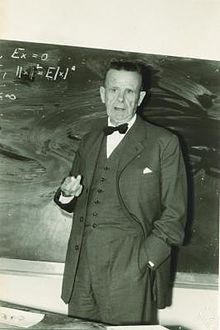Harald Cramér
| Harald Cramér | |
|---|---|
 |
|
| Born |
25 September 1893 , Sweden |
| Died | 5 October 1985 (aged 92) , Sweden |
| Residence | Sweden |
| Nationality | Swedish |
| Fields | Statistics, Probability theory, Number theory |
| Institutions | |
| Alma mater | |
| Doctoral advisor | Marcel Riesz |
| Doctoral students |
Herman Wold Kai Lai Chung Ulf Grenander |
| Known for |
Cramér–Rao bound Cramér's conjecture Cramér's theorem Cramér–Wold theorem Cramér–von Mises criterion Cramér function of large deviations theory Ruin theory Cramér's V Cramérs inequality |
| Notable awards | Guy Medal (Gold, 1972) |
| Spouse | Marta Hansson |
| Children | Marie-Louise, Tomas, Kim |
Harald Cramér (Swedish: [kraˈmeːr]; 25 September 1893 – 5 October 1985) was a Swedish mathematician, actuary, and statistician, specializing in mathematical statistics and probabilistic number theory. John Kingman described him as "one of the giants of statistical theory".
Harald Cramér was born in , Sweden on 25 September 1893. Cramér remained close to Stockholm for most of his life. He entered the as an undergraduate in 1912, where he studied mathematics and chemistry. During this period, he was a research assistant under the famous chemist, Hans von Euler-Chelpin, with whom he published his first five articles from 1913 to 1914. Following his lab experience, he began to focus solely on mathematics. He eventually began his work on his doctoral studies in mathematics which were supervised by Marcel Riesz at the University of Stockholm. Also influenced by G. H. Hardy, Cramér's research led to a PhD in 1917 for his thesis "On a class of Dirichlet series".
Following his PhD, he served as an Assistant Professor of Mathematics at Stockholm University from 1917 to 1929. Early on, Cramér was highly involved in analytic number theory. He also made some important statistical contributions to the distribution of primes and twin primes. His most famous paper on this subject is entitled "On the order of magnitude of the difference between consecutive prime numbers", which provided a rigorous account of the constructive role in which probability applied to number theory and included an estimate for prime gaps that became known as Cramér's conjecture.
...
Wikipedia
